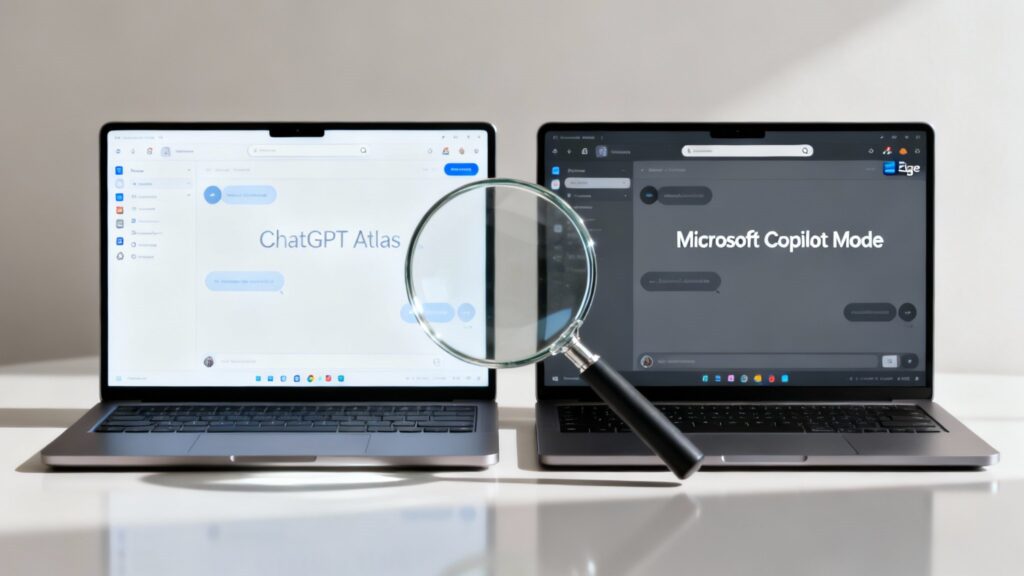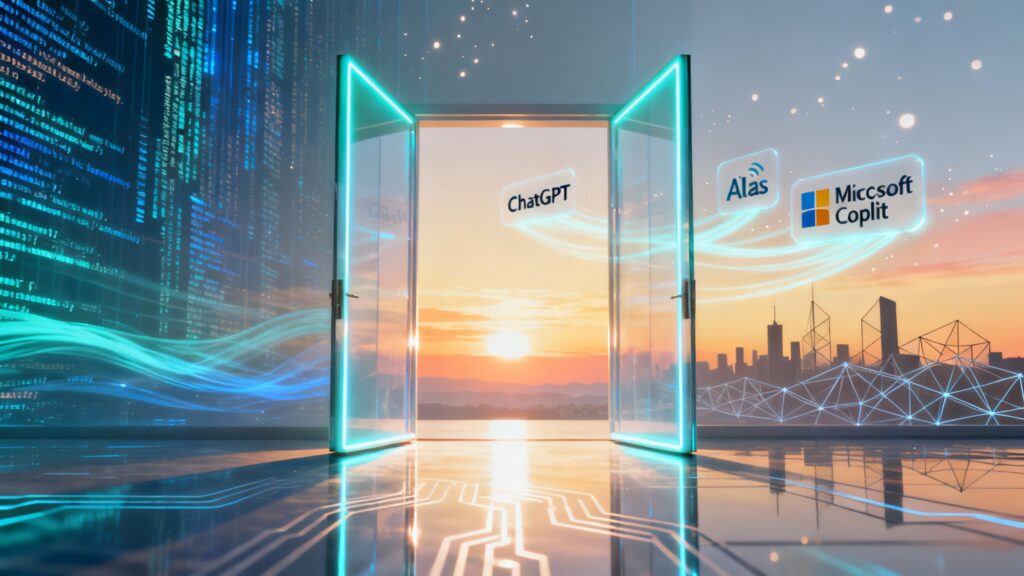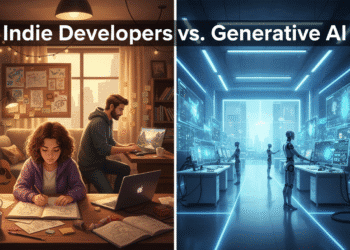Tech giants unveil strikingly similar AI-powered browsers just days apart, signaling a new era in how we navigate the internet

The race to revolutionize web browsing just got a whole lot more interesting. In a dramatic turn of events that has Silicon Valley buzzing, two tech powerhouses have launched nearly identical AI-powered browsers within 48 hours of each other. It’s a move that’s raising eyebrows and questions about the future of how we interact with the internet.
OpenAI Fires the First Shot with ChatGPT Atlas
On Tuesday, October 21, 2025, OpenAI made waves by announcing ChatGPT Atlas, its first foray into the browser market. This isn’t just another browser with some AI features tacked on. It’s a fundamental reimagining of what browsing can be.
The company positioned Atlas as a direct challenge to Google’s long-standing dominance in how people find information online. And they’re not being subtle about it. ChatGPT Atlas puts AI front and center, making it the core of the entire browsing experience rather than just an add-on feature.
Ben Goodger, OpenAI’s Engineering Lead for Atlas, explained during a livestream that ChatGPT is absolutely central to their first browser. Users can chat directly with their search results, similar to what you’d experience with Perplexity or Google’s AI Mode. But OpenAI is taking things several steps further.
The browser initially rolled out on macOS, with Windows, iOS, and Android support coming soon. Here’s the kicker: it’s available to all free users right from launch. That’s a bold move that signals OpenAI’s serious intentions to capture market share quickly.
What Makes Atlas Different?
So what exactly sets ChatGPT Atlas apart from your standard Chrome or Safari experience? The answer lies in its killer feature: the built-in chatbot that sits in a side panel.
This might sound minor at first. But think about your typical workflow. How many times a day do you copy text from a webpage, switch to ChatGPT, paste it in, and ask a question? Or drag files and links around to provide context? It’s tedious. It breaks your flow.
Atlas eliminates that friction entirely. The sidecar feature automatically has context for whatever’s on your screen. According to Adam Fry, OpenAI’s Product Lead, this seamless integration makes for a dramatically smoother user experience.
But here’s where things get really interesting and potentially controversial. ChatGPT Atlas has “browser history” functionality. That means ChatGPT can log the websites you visit and what you do on them. It then uses that information to make its answers more personalized.
Privacy advocates might have concerns. But OpenAI is betting that users will trade some privacy for significantly more helpful AI assistance.
The Agent Mode Wild Card
Like other AI-powered browsers hitting the market, Atlas features an AI agent designed to automate web-based tasks on your behalf. In “agent mode,” you can ask ChatGPT to complete small tasks in the browser for you.
Want to book a hotel? Fill out a form? Compare products across multiple tabs? The AI agent aims to handle it. However, there’s a catch. This feature is only available to ChatGPT users on the Plus, Pro, and Business tiers at launch.
TechCrunch’s testing of similar features in other browsers has revealed that early versions of web-browsing AI agents still have room for improvement. While they work well for simple tasks, they struggle with more complex, cumbersome problems that users might really want to offload to an AI system.
Microsoft Strikes Back Fast
If you thought OpenAI’s announcement was big news, buckle up. Just two days later, on Thursday, October 23, Microsoft dropped its own bombshell.
The company released a new batch of features for its AI assistant, including Copilot Mode in Microsoft Edge. And when we say it’s similar to Atlas, we’re not exaggerating. The visual and functional similarities are striking almost uncanny.
Mustafa Suleyman, CEO of Microsoft AI, described the new product in remarkably similar terms to OpenAI’s pitch. “Copilot Mode in Edge is evolving into an AI browser that is your dynamic, intelligent companion,” Suleyman wrote. “With your permission, Copilot can see and reason over your open tabs, summarize and compare information, and even take actions like booking a hotel or filling out forms.”
Sound familiar? It should. That’s almost exactly what OpenAI promised with Atlas.
The Timing Raises Eyebrows
Now, before conspiracy theories run wild, it’s important to note that Microsoft’s Copilot Mode wasn’t thrown together overnight. The official launch for Edge’s Copilot Mode actually happened back in July, when it rolled out with basic features like a search bar on new tabs and natural voice navigation.
But the mode was opt-in and didn’t generate much buzz. Thursday’s event was different. Microsoft got more ambitious, introducing “Actions” that allow Copilot to fill out forms or book hotels, and “Journeys” that let Copilot trace connections between your open tabs.
The release has been scheduled for weeks. Development likely took months. Neither company invented the concept of an AI-assisted web browser. But the near-simultaneous high-profile launches? That’s no coincidence.
A Tale of Two Browsers

Let’s talk about just how similar these two products really are. When you put demo frames from both announcements side by side, the resemblance is remarkable.
Both integrate a chatbot into the “new tab” screen. Both feature clean, minimalist interfaces. Both promise to see and reason over your open tabs. Both can summarize and compare information. Both can take actions like booking hotels or filling out forms.
The differences? They’re mostly cosmetic. Copilot for Edge has a darker background. It uses text instead of a logo. The close and minimize buttons follow Windows conventions rather than MacOS conventions. Copilot opts for a full-tab “ride-along” function instead of a split-screen approach.
That’s about it. As one industry observer noted, these are two very similar pictures of essentially the same product.
Why Do They Look So Alike?
Part of the similarity is functional. There are only so many ways to integrate a chatbot window into a “new tab” screen while maintaining a clean, user-friendly interface. People like clean browsers. Design constraints naturally push developers toward similar solutions.
The real distinction, experts say, will come from the underlying AI models powering each browser. Microsoft’s Copilot is built on different technology than OpenAI’s ChatGPT. Those differences in the AI engines will likely define the actual user experience more than any visual design choices.
Browsers mostly look the same anyway, right? Chrome, Safari, Firefox, Edge they all follow similar design principles. But given the high stakes of the AI race and the increasingly tense relationship between Microsoft and OpenAI, the timing feels significant.
The ‘Frenemies’ Dynamic
The relationship between Microsoft and OpenAI is complicated, to say the least. Microsoft has invested billions in OpenAI and integrates its technology across numerous products. They’re partners in many ways.
But they’re also increasingly competitors. Microsoft has its own AI ambitions that extend far beyond just licensing OpenAI’s technology. OpenAI, meanwhile, is building products that directly compete with Microsoft’s offerings.
Industry insiders have started calling them “frenemies” friends and enemies at the same time. The near-simultaneous browser launches underscore this competitive tension perfectly. They’re working together in some areas while racing against each other in others.
The Bigger Picture: Challenging Google’s Throne
Both companies have their sights set on a much bigger target: Google Chrome. With more than 3 billion users around the globe, Chrome has dominated the browser market for years. It’s not just a browser it’s how billions of people access the internet.
Can AI-powered browsers put a dent in that dominance? That remains to be seen. AI browsers are quite buzzy in Silicon Valley right now. Startups like Perplexity with its Comet browser and The Browser Company with Dia are also in the mix. But their impact in the broader world is still limited.
Nick Turley, Head of ChatGPT at OpenAI, told TechCrunch that he’s inspired by the way browsers have redefined what an operating system can look like. Browsers have revolutionized how people get work done online. Turley thinks ChatGPT represents a similar phenomenon a fundamental shift in how we interact with technology.
What This Means for Users
For everyday users, this browser war could be great news. Competition drives innovation. When tech giants are racing to outdo each other, consumers typically benefit from better products, more features, and competitive pricing.
The promise of AI-powered browsers is compelling. Imagine never having to copy and paste between tabs again. Imagine having an intelligent assistant that understands the context of everything you’re doing online and can help you accomplish tasks faster.
Need to compare prices across multiple shopping sites? Your browser could do that automatically. Researching a topic and need to synthesize information from dozens of sources? Your AI assistant could summarize it all for you. Filling out repetitive forms? Let the AI handle it.
These aren’t science fiction scenarios. They’re features that both Atlas and Copilot Mode are promising right now.
The Privacy Question
But there’s a flip side. For these AI browsers to work their magic, they need access to your browsing data. They need to see what you’re looking at, where you’re going, and what you’re doing online.
Both companies emphasize that this happens “with your permission.” But how many users will really understand what they’re agreeing to? How will this data be stored and used? Could it be used to train AI models? What happens if there’s a data breach?
These are questions that haven’t been fully answered yet. As these browsers roll out to millions of users, privacy and security concerns will likely become more prominent in the conversation.
What Comes Next?
The AI browser race is just getting started. We’re likely to see rapid iteration and improvement from both Microsoft and OpenAI in the coming months. Other players won’t sit idle either. Google is already working on AI features for Chrome. Apple has its own AI ambitions.
The next few months will be crucial. Early user adoption numbers will tell us whether people are actually ready to switch from their familiar browsers to these new AI-powered alternatives. The performance of the AI agents will be critical if they can’t reliably handle complex tasks, users will quickly lose interest.
We’ll also see how the privacy concerns play out. If there are any security incidents or data misuse scandals, they could derail adoption quickly.
The Verdict: A New Chapter in Web Browsing

One thing is clear: we’re witnessing a new chapter in the evolution of web browsing. The internet has been around for decades, but how we navigate it is still evolving. From the early days of Netscape Navigator to the rise of Google Chrome, browsers have continually adapted to changing user needs and technological capabilities.
AI-powered browsers represent the next evolution. Whether it’s OpenAI’s ChatGPT Atlas or Microsoft’s Copilot Mode in Edge, these products are fundamentally rethinking what a browser can and should do.
The fact that two major tech companies launched nearly identical products within 48 hours of each other tells us something important: this is where the industry believes the future is heading. They’re betting billions that AI-integrated browsing is the next big thing.
Will they be right? Only time will tell. But one thing’s for sure the browser wars are back, and they’re more interesting than ever.
Sources
- Times of India – Microsoft announces ‘rival’ to OpenAI’s AI browser ChatGPT Atlas
- TechCrunch – OpenAI launches an AI-powered browser: ChatGPT Atlas
- TechCrunch – Two days after OpenAI’s Atlas, Microsoft launches a nearly identical AI browser
- APKMirror – Microsoft Edge AI Browser Release









